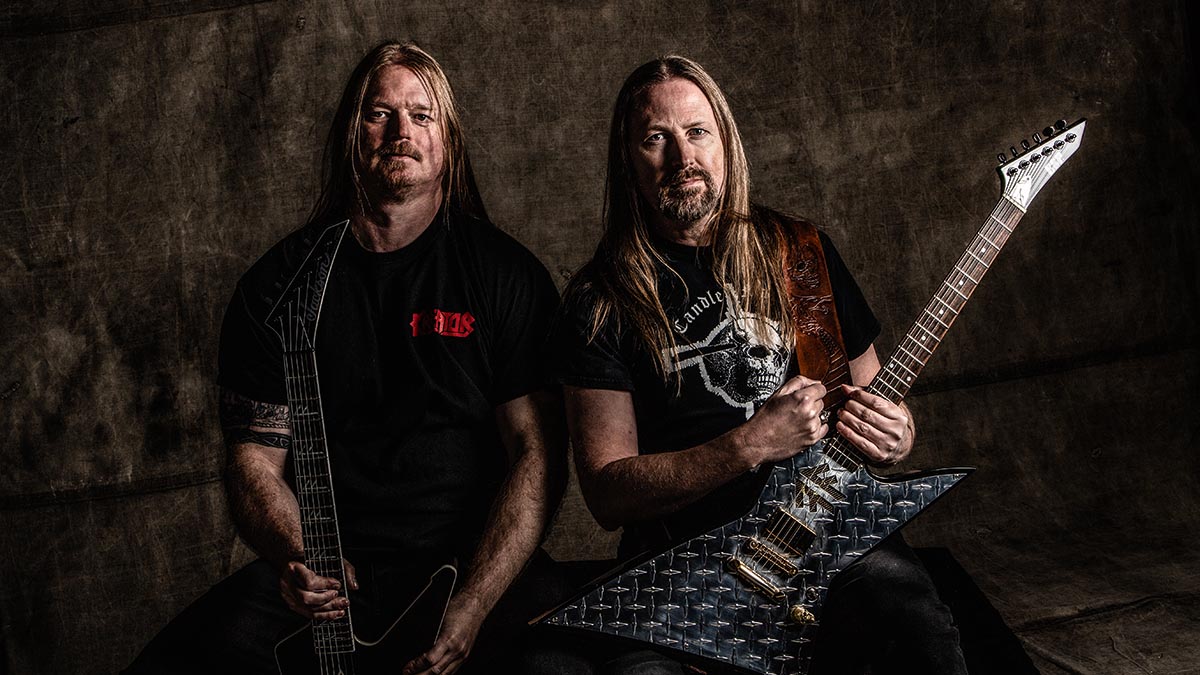Amon Amarth on what drew them to baritone tunings over 7-strings and why no amount of pimping can polish a turd of a riff
The Swedish Viking metal stalwarts' Olavi Mikkonen and Johan Söderberg unpack the particulars of a brutal sound that has taken a turn for the dark on their latest, death metal-inflected epic, The Great Heathen Army

Over the course of three decades, Amon Amarth have marched forth as standard bearers for a unique brand of melodic metal, which sets epic tales of gods and warriors to a thunderous soundtrack of tremolo-picked riffs, drop-tuned chugs and melodic solos.
Famed for their theatrical live shows and aggressive-yet-catchy songcraft, the band has risen to a much beloved status among fans of anthemic metal all over the world. Now, under the steam of their 12th studio album The Great Heathen Army, lead guitarist Olavi Mikkonen reflects on how the band’s rise has been more of a stoic campaign than a surprise dawn raid.
“We never really became a big band from the start. We always took small steps, so the growth for our band has been great in that way,” he explains. “We appreciate where we are. We don’t take things for granted, and we can see that the reason we are where we are today is because of hard work. There’s millions of bands behind our backs trying to take our position, so we need to continue to work hard.”
This uncompromising work ethic is writ large upon the nine track aural assault that is The Great Heathen Army – sonically dense, foreboding and without a let up in pace throughout its course.
Mikkonen’s axe-wielding bandmate, Johan Söderberg, explains that the goal was “just to make it a little darker and more death metal,” than 2019’s Berserker. “That album was more in the heavy metal style,” he says, “and we wanted to go back to the darker themes again. The pandemic for sure added frustration, so that made the songs more brutal.”
To carry this darkness and frustration, the pair slackened their strings down to reach the brutal lows of B standard (also known as baritone tuning), where each string is lowered two and a half steps – or a perfect 4th – from the standard EADGBE tuning. A query as to whether adopting 7-string guitars, in the vein of many progressive metallers, might make life easier at these abyssal depths elicits a unified “no” from Mikkonen and Söderberg.
For Mikkonen, it’s about simplicity: “We don’t have to use 7-strings because we’re already tuned down to B,” he explains. “I don’t need to make it even more complicated!” For Söderberg, it all comes down to playability: “I don’t like those 7-strings because I don’t like the feel of the necks – they’re too wide. What we do is put much heavier strings on. I use D’Addario strings and they’re 13-62 in thickness, so basically it’s like a 7-string guitar, but without the top string.”
Get The Pick Newsletter
All the latest guitar news, interviews, lessons, reviews, deals and more, direct to your inbox!
In the axe department, Söderberg has long favoured an ESP E-II EX, which he’s self-modded and replaced the seldom-used neck pickup with a light. Also with utility in mind, he explains: “I like this EX shape because it’s very well balanced when you stand up and play. Some guitars are front heavy so the neck tips over all the time.”
Mikkonen depends on a similarly streamlined custom Jackson X-Stroyer. “I’m an easy guy,” he laughs. “I just use one pickup and volume and that’s it. There’s no tremolo or anything, it’s just easy going.”
Their amp and effects rigs were revolutionised by the advent of the Kemper Profiler, which now serves all their tonal needs. “The Kemper is a fantastic thing,” says Mikkonen. “It takes up little space, it’s easy to switch sounds. It’s fantastic, compared to how it was when I started to play, when you had huge amps and tons of different pedals that were always running out of batteries.”
Söderberg adds: “We make profiles ourselves. We usually use some kind of EVH 5150 or something, then usually we put a Tube Screamer in front of the amp and then we make a profile of that. That’s pretty much the only sound I use. Then, when I do lead parts, I just put a delay effect on it. Then I use one clean sound as well.”
In an ingenious display of practical nous, Söderberg has also rigged a pedalboard with five footswitches to alternate between these three core sounds – thus increasing the probability of stomping on the right one.
When you run around on stage and there’s flamethrowers and bombs going off everywhere and lights blinking, it’s easier to step on the wrong knobs if you have too many knobs to step on!
Johan Söderberg
“I have two of the same rhythm sound next to each other. Then I have two more knobs for the lead sound, with the same sound on both, and then one for the clean sound.” He laughs: “When you run around on stage and there’s flamethrowers and bombs going off everywhere and lights blinking, it’s easier to step on the wrong knobs if you have too many knobs to step on!”
When it comes to writing, the pair will typically compose separately in their own studios, but their respective guitar playing counterpart is never far from mind. Explains Mikkonen, “When I write stuff, I’m writing Johan’s parts too, and it’s the same thing with him. He writes my parts in his songs. There’s only a few things that I’ll want both guys playing at the same time. I usually want things to be harmonised.”
Amon Amarth’s no frills approach to gear leaves plenty of room for their hulking great dual-guitar, riff-heavy sound to take centre stage on The Great Heathen Army. As Mikkonen puts it: “In the end, what really matters is the riff. If you don’t have a good riff, it doesn’t matter how much you ‘pimp’ it, it’s never going to be good. You can’t polish a turd and it’s the same thing with riffs.”
- The Great Heathen Army is out now via Metal Blade.
Since graduating university with a degree in English, Ellie has spent the last decade working in a variety of media, marketing and live events roles. As well as being a regular contributor to GuitarWorld.com, she currently heads up the marketing team of a mid-scale venue in the south-west of England. She started dabbling with guitars around the age of seven and has been borderline obsessed ever since. She has a particular fascination with alternate tunings, is forever hunting for the perfect slide for the smaller-handed guitarist, and derives a sadistic pleasure from bothering her drummer mates with a preference for wonky time signatures.
“I always felt like that record could have been better if we had worked on it some more”: Looking for a blockbuster comeback album, Aerosmith turned to Van Halen producer Ted Templeman. For Joe Perry, it served as a learning experience
“It's like saying, ‘Give a man a Les Paul, and he becomes Eric Clapton. It's not true’”: David Gilmour and Roger Waters hit back at criticism of the band's over-reliance on gear and synths when crafting The Dark Side of The Moon in newly unearthed clip











